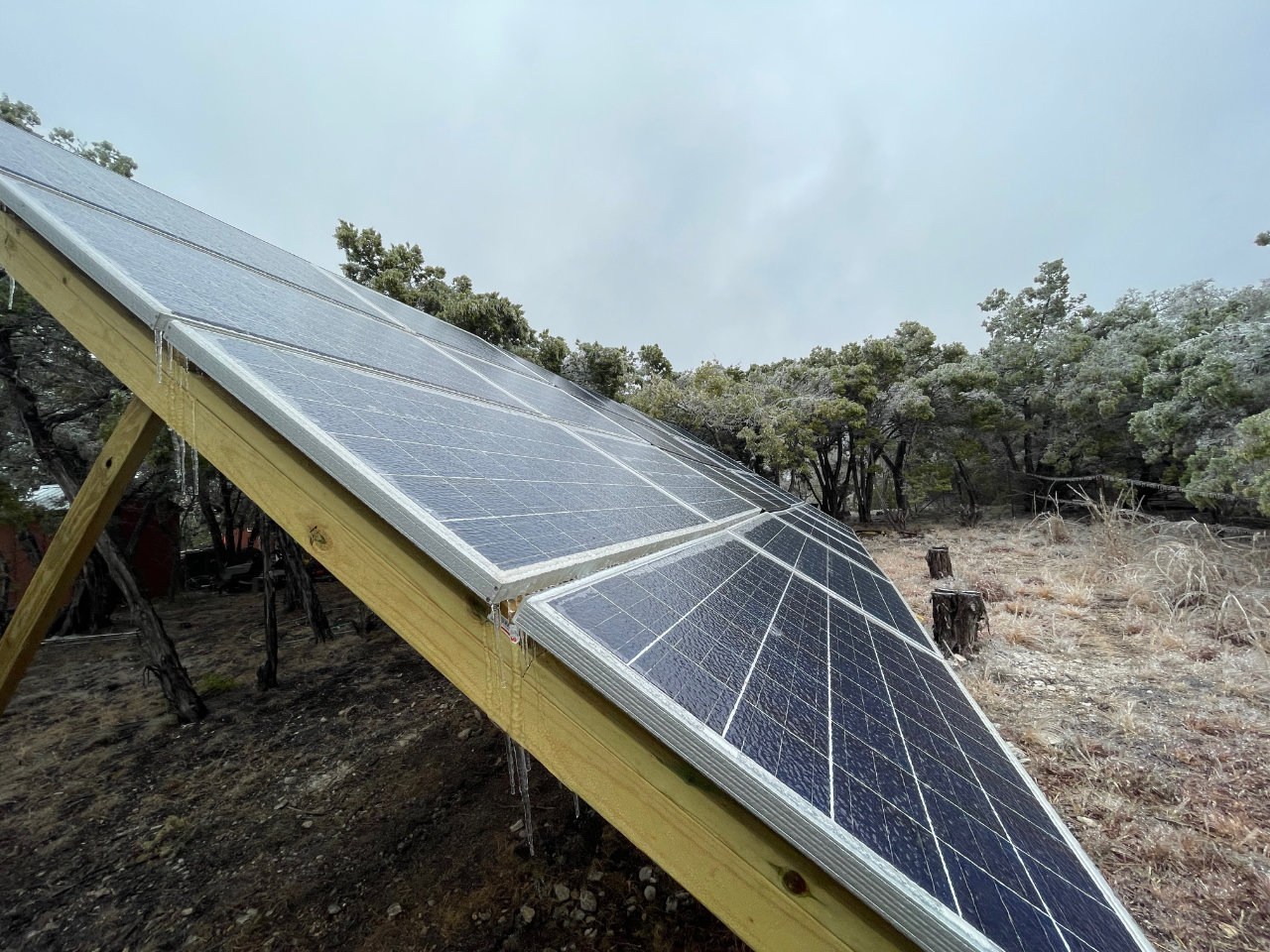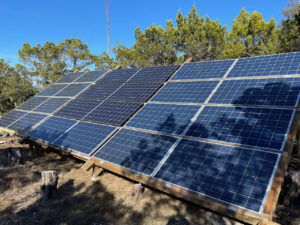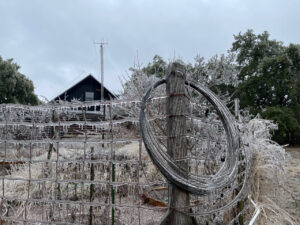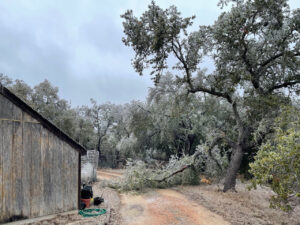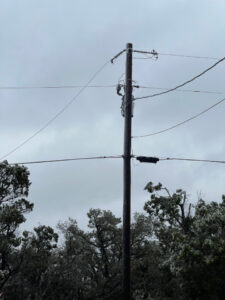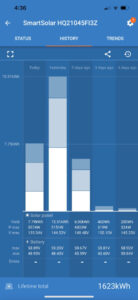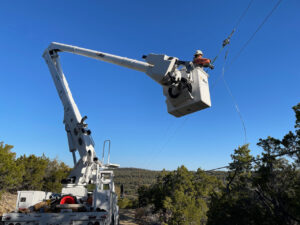Solar Power Eases A Bad Ice Storm
Solar Power Update
With several posts regarding the installation of solar power at Roy Creek Ranch, one might wonder whether or not it worked. Read on and learn about our experience in an emergency situation.
The Solar Array is enlarged
First an update. In December of 2022, I added a third bay of solar panels to the array with the help of my friend, Joe. I’ve written before on panel installation and upgrades, so I’ll keep these comments short. The third bay added 8 more panels, making a total of 24. At an estimated 225 watts of peak production per panel, the new array configuration has a theoretical capacity of 5,400 watts. As described in the last post on this solar installation, that is limited by the charge controller — with a maximum throughput of 5000 watts.
An Historic Icing Event in the Texas Hill Country
On Monday, January 30, 2023, freezing precipitation began an historic ice storm in Austin and the Texas Hill Country. Deposited over three days, the resulting ice led to power outages affecting a large number of homes in the area. By a week later, not all of the power in the area had been restored. Here at the ranch, we were without power from mid-afternoon on Thursday until Sunday afternoon three days later. Many of the outages were a result of falling tree limbs, but a substantial number were the result of ice loads snapping power lines where no trees were involved.
Icing Timeline
Monday, January 30 — The storm begins.
The first significant ice accumulation was on Monday night. The next day, we noticed a light glaze of ice on many outside surfaces — enough that we decided to stay put for the day. Freezing drizzle throughout Tuesday and rain overnight increased ice accumulations. By Wednesday morning, some power was out in Austin. A slight warm-up on Wednesday made it possible for us to keep a mid-day appointment in Johnson City. We still had power, and thought we had missed the worst of it.
Thursday, February 2 — Tree Damage and Downed Power Lines
The main event was nearly an inch and a half of rain over Wednesday night. A significant warm-up was predicted during the day on Thursday, but I awoke to nearly half of an inch or more ice accumulation. It hadn’t started melting yet, and as I surveyed the damage, I heard what sounded like small arms fire all around me as trees cracked and fell. In one case, a majestic Western Cedar, perhaps 25 feet tall, exploded and fell under the ice load as I watched.
By mid-day, the roads had cleared and we thought it safe enough to run an errand or two. When we returned later on, the power was off. A 14,400-volt line near our house had snapped. With just a couple of hours of daylight remaining, I began implementing our emergency power plan.
Our system is designed to provide power in the event of a grid failure. I built it as three systems as time and money permitted. One system is exclusively for pumping water from a deep well, with a second, larger system designed to power the shop and provide backup power to the house. A third system powers the ham radio equipment. By nightfall, I had disconnected from the grid and routed enough power into the house for a few lights, device charging and a few small appliances. The house was a little chilly, because there wasn’t enough power to run heating devices, but a comforter on the bed made for cozy sleeping.
Friday, February 3 — Solar Power to the Rescue
Friday morning dawned bright and sunny and we had sufficient solar power by 9:30 AM to cook breakfast. We have a propane range, but also used a 1500-watt electric kettle for coffee and tea and a toaster oven. One of the 6-volt storage batteries for the well pump had failed so we decided to venture into town for a replacement. It was installed by late afternoon, allowing us plenty of water. With a tankless propane water heater, we could also offer hot showers to a few of our neighbors.
After dinner, I turned on my radios and worked a few contacts. The ham station has separate solar panels and batteries so we won’t be without communications. This system also runs a Apple M1 Mac Mini computer tethered to a cell-phone hotspot. The M1 is very efficient and only uses about 100 watts. The house was a little colder going to bed, but that comforter worked wonders again.
Saturday, February 4 — Solar Power produces Record Energy
Saturday morning was sunny with the promise of warmer temperatures later in the day. With a full day of sun and no errands, we were able to maximize our use of the solar power. I tried to keep it busy most of the day. By mid-day we had used the electric kettle, toaster oven, a small space heater and even run the dish washer. I was able to restore Wi-Fi-based Internet service and we both had a hot shower. The only thing we lacked was building heat. Outdoor temperatures rose to the low 70’s, so we opened the windows to warm up the house.
Sunday, February 5 — Grid Restored
Sunday was largely a repeat of Saturday with even higher afternoon temps, and power was restored by around 2 PM. During the three days off-grid, we generated over 30 kilowatt-hours of power from Thursday at 2 PM until Sunday at 2 PM. On Saturday, we maxed-out the charge controller at 5,151 watts. With the exception of building heat, the system had provided all the power we needed for lighting, cooking, cleaning, communications and even entertainment.
Storm Aftermath
As ice storms go, this one is the worst I’ve ever seen. I think the damage is especially severe because we’ve been in an “exceptional drought” pattern for the last several months resulting in stressed and weakened trees. There are a lot of downed limbs, and a few trees that were destroyed completely. A couple of those were simply uprooted or broken along the trunk by the weight of the ice. We are fortunate to have chain saws and a wood chipper powered by a 50-horse tractor, so clean up will be possible without too much cost. It will take weeks though.
Next Steps
When we built the house in 1996, we made a provision for adding a wood stove in the living room. Because of its cost, and the fact that we would only be able to use it for a few weeks each winter, it was never installed. With two grid-down events in the last three winter seasons, and a 10 acre supply of firewood, I’m reconsidering that wood stove. It would have been nice on those chilly nights! Maybe something like this for next winter?
